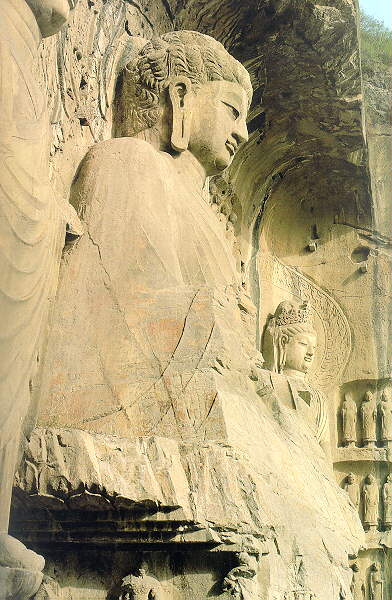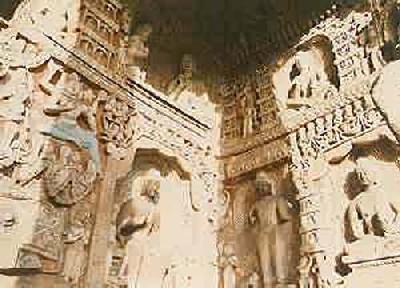
 |
To make Buddhism more acceptable and gain more followers, Buddhists used every means possible -- literature, art, music, murals and sculptures -- to demonstrate its thought and content. Grotto art is an important component of the Buddhist art movement. Understanding Chinese grotto art is helpful to understanding the development of Buddhism in China.

Situated in the northern Shanxi Province, the Yungang Grottos were constructed during the reign of Emperor Wencheng of the Northern Wei Dynasty (386-534). The digging continued for some 40 years, with a work force of some 10,000 sculptors. When the Northern Wei Dynasty moved its capital to Luoyang in 494, the grottos were almost complete. The first grottos were built under the direct leadership of the emperor and ruling officials. Today there are 53 individual grottos with over 1,100 small shrines and more than 51,000 statues. The subjects mainly involve Buddha and Buddhist stories, abundant in both content and manner. Situated in the Midwest of the Yungang Grottos, the No Five Grottos were the first to be constructed; they were built under the direction of a famous monk during the reign of Emperor Wencheng. The No 20 Grottos, also in the Midwest, are in the open air, with a sitting statue of Sakyamuni as the main sculpture. Towering at 13.7 meters, the sculpture has thick, broad shoulders, a chubby face, thin lips, steep bridge of the nose, and a dignified countenance. An exquisite fire design, sitting Buddha and flying Aspara serve as the background of the piece, highlighting its majestic nature. The No 20 Grottos are representative works of the Yungang Grottos. Adopting the Xiuguqingxiang technique from the Central Plain, the emotion and manner of Buddha, as well as Bodhisattva, are more vivid and true to life. The image of the flying Aspara is also more graceful -- a result of the Sinicization of Buddhism.
Groups of the vividly depicted flying Aspara were found in the inner walls, outside walls, Buddha's halo and caisson ceilings. The flying Aspara revealed Buddhists' wish of going to Sukhavati (pure land). The personified statues of Buddha are regarded as gems of Chinese ancient culture.





















